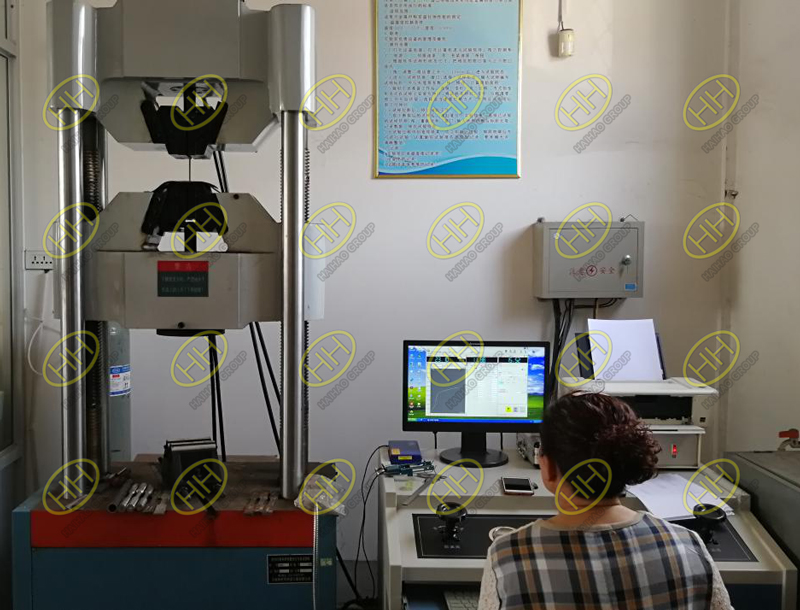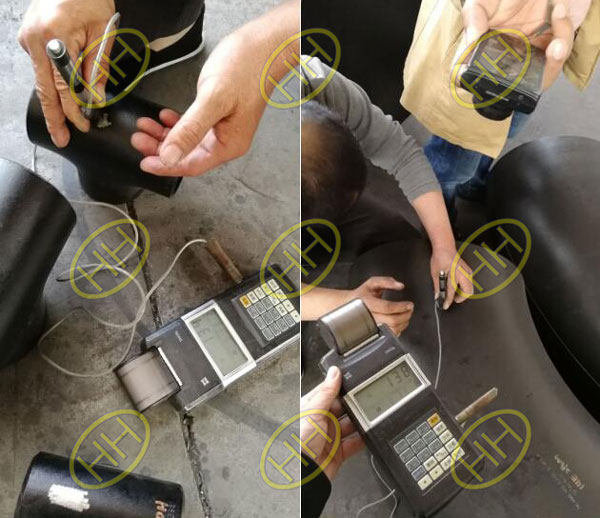The mechanical performance indicators of steel pipes often appear in our industry, so do you know about these indicators? Let me explain today.(Test of mechanical properties for EN10204 3.2 certification)
1.Yield point (σs)
When the steel or specimen is stretched, when the stress exceeds the elastic limit, even if the stress no longer increases, the steel or specimen continues to undergo significant plastic deformation. This phenomenon is called yielding, and the minimum stress value when yielding occurs is For the yield point. Let Ps be the external force at the yield point s, and Fo be the cross-sectional area of the specimen, then the yield point σs = Ps / Fo (MPa), MPa is called megapascal equal to N (Newton) / mm2, (MPa = 106Pa, Pa: Pascal = N / m2)

Mechanical properties test by BV
2.Yield strength (σ0.2)
Some metal materials have extremely insignificant yield points and are difficult to measure. Therefore, in order to measure the material’s yield characteristics, it is stipulated that the stress at which a permanent residual plastic deformation equals a certain value (generally 0.2% of the original length) is called a condition Yield strength or abbreviated yield strength σ0.2.
3.Tensile strength (σb)
The maximum stress value reached during the stretching of the material from the beginning to the occurrence of fracture. It indicates the capacity of the steel to resist fracture. Corresponding to tensile strength are compressive strength and flexural strength. Let Pb be the maximum tensile force achieved before the material is broken, and Fo be the cross-sectional area of the sample, then the tensile strength σb = Pb / Fo (MPa).
4.Elongation (δs)
After the material is broken, the percentage of the length of the plastic elongation to the length of the original sample is called the elongation or elongation.
5.Yield ratio (σs / σb)
The ratio of the yield point (yield strength) of a steel to the tensile strength is called the yield ratio. The greater the yield strength ratio, the higher the reliability of the structural parts. Generally, the yield strength ratio of carbon steel is 0.6-0.65, low alloy structural steel is 0.65-0.75, and alloy structural steel is 0.84-0.86.

Mechanical properties test by bv for EN10204 3.2 certification
6.Hardness
Hardness refers to the ability of a material to resist the pressing of a hard object onto its surface. It is one of the important performance indicators of metal materials. Generally, the higher the hardness, the better the abrasion resistance. Common hardness indicators are Brinell hardness, Rockwell hardness, and Vickers hardness.
(1)Brinell hardness (HB): Press a hardened steel ball of a certain size (generally 10mm in diameter) into the surface of the material with a certain load (generally 3000kg) and keep it for a period of time. After unloading, the ratio of the load to the indentation area, It is the Brinell hardness value (HB) in kilogram-force / mm2 (N / mm2).
(2)Rockwell hardness (HR) When HB> 450 or the sample is too small, the Brinell hardness test cannot be used and the Rockwell hardness measurement is used instead. It is a diamond cone with a vertex angle of 120 °or a steel ball with a diameter of 1.59 and 3.18mm. It is pressed into the surface of the material under a certain load, and the hardness of the material is obtained from the depth of the indentation. According to the hardness of the test material, it is expressed in three different scales:
HRA: It is a hardness obtained by using a 60kg load and a diamond cone indenter. It is used for materials with extremely high hardness (such as cemented carbide).
HRB: It is a hardened steel ball with a load of 100kg and a diameter of 1.58mm. The hardness is obtained and used for materials with lower hardness (such as annealed steel, cast iron, etc.).
HRC: It is a hardness obtained by using a 150kg load and a diamond cone indenter. It is used for materials with high hardness (such as quenched steel).
(3)Vickers hardness (HV) The diamond square cone indenter with a load of less than 120kg and a vertex angle of 136 ° is pressed into the surface of the material. The surface area of the material indentation pit is divided by the load value to obtain the Vickers hardness value ( HV).
As a professional piping supplier,Haihao Group supply the high quality products and do the mechanical property test,if you want to know more about our products,please feel free to contact us.Email:sales@haihaogroup.com







